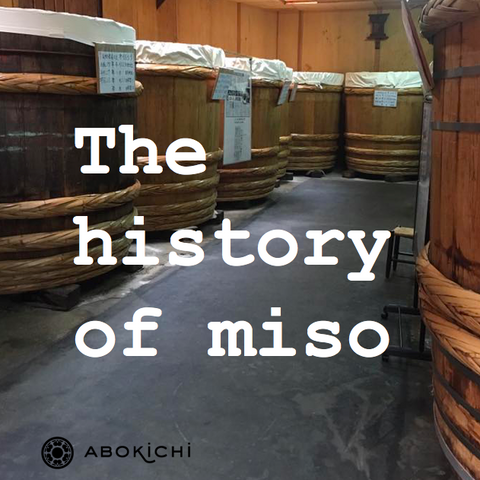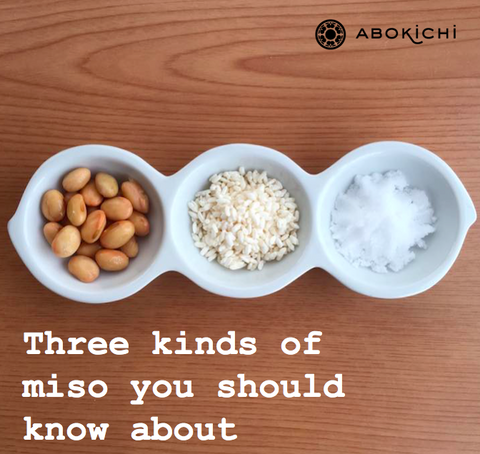The origin of miso
It is said that origin of miso dates back to ancient China and also it is said that miso was originally unique to Japan. So, actually its origins have not been cleared and there are two theories about origin, China and Japan.
In Japanese theory, it is said that the prototype of Japanese miso dates back to the Yayoi period, (an Iron Age era in the history of Japan traditionally dated 300 BCE to 300 CE).
In Japan, salting started from the Jomon period, which is the period just before yayoi period (and the time in Prehistoric Japan from about 16,500 years ago to about 2,300 years ago).
Since traces of salting grains in ruins, which are seemly to have been made from the late Jomon period to the Yayoi period, has been found, it seems that salted food such as soy sauce started to be made at Jomon period. In ruins of the Kofun period, which is next period of Yayoi period, traces of salting grains which were fermented with malt have been found.
The other theory is that miso’s origin is “SHOU (HISHIO)” and “SHI (KUKI)” which originated in the ancient Chinese continent.
SHOU (HISHIO) is immersed beast and fish meat, which is marinated in a pod for more than 100 days after mixing them with salt and liquor. It seems that it was used like sauce and soy sauce which are used now as they are. At around beginning of 100 BC, “SHI(KUKI)” ,which is made by fermenting soybeans and millets, started to be made. This can also be said to be one kind of “SHOU(HISHIO) if it is interpreted in a broad sense.
We do not know exactly how and when they were introduced to Japan. But prosperity theory states that kento-shi ( Japanese envoy to China during the Tang Dynasty) brought them to Japan.
the Asuka period · · · Miso's predecessor
In the Taiho-ryo (Taiho Administrative Code) of the Taiho Ritsuryo (Taiho Code), which was established in 701, the words “SHOU (HISHIO)” , “SHI (KUKI)”(which are mentioned above) and “MISHOU” which was not used in Chinese continent, were written. It is thought that this word “MISHOU” can change into “MISHO” and then “MISO”. There were other characters which sound “MISO” and were written in the Taiho-ryo.
The words “SHOU (HISHIO)” and “SHI (KUKI)” are on the list of foods which one of the Imperial Household Department dealt with.
The Heian Period · · · Birth of Miso
In “Nihon Sandai Jitsuroku” (The True History of Three Reigns of Japan), which is a Japanese history text compiled during Heian period and completed in the year 901, there is the word "miso" and this is the oldest record of miso. The word is also written in “Wamyo Ruijusho”, which is a dictionary compiled in the Heian period.
According to the Engi-Shiki Code (detailed rules of enforcement of code), miso was used as salary for high-level bureaucrats or gift and miso was treated as precious seasoning. It seems that it was such a luxury thing that general people can’t afford it.
Buying and selling miso started before this era. The first miso specialty shop, which appear in the historical record, is “HISHIO” shop in Higashi city of Kyoto and “MISHOU” shop in Nishi-city in Kyoto. In addition to this public market, there were rice, oil, dried fish shops, as well as shops such as silk and cotton, combs, brushes and needles shops. Although miso is still a luxury item, it had been becoming a necessity for daily life equal to these items.

Kamakura period ... Japanese Food revolution! The Appearance of Miso Soup
Appearane of "Miso soup" is one of the most important events in miso history!!! In this era, in the temple of Zen sect monk who came from China brought ”Mortar”, which has started to be used. And "Grinded Miso" which is made by grinding "Grain miso" was made. Since grinded miso is easy to dissolve in water, that became now miso soup. Due to the appearance of miso soup, the basic idea of Kamakura Samurai's meal which is called "Ichiju issai”, set of one soup and one dish, is established, and it had been handed down for a long time. Moreover, although the content of the "issai(one dish)" changed a lot, "ichiju(one soup)" was always miso soup.
Now "ichiju issai" is said to be like a synonym of rough food, but it was variable food, which people in privileged class such as "souvenirs" and monks ate at the time. It is from Muromachi era that Misso has become popular in general people. It is said that it has been also around this time that miso began to be made which is almost the same as the present one as a result of raw material blending ratio.
Incidentally, Kinzanji-miso which is a specialty product of Wakayama prefecture appeared in this era. It is said that Kakushin, who was a Zen priest in Shinshu went to Song in Chinese continent to study at "Kanzanji Temple and Kozanji Temple (Both readings are Kinzanji) “, brought miso making method from song to Kishu area in Japan. Later he settled in Yura in Japan and opened the Seihoji Temple (later Gokokuji). And Kinzanji-Miso making was spread around Yuasa (). There is a theory that this soup of Miso (Tamari) ,,as a seasoning is prototype of modern Japanese soy sauce. At Yuasa area in Wakayama prefecture, there are still many breweries of Kinzanji-Miso and Yuasa Soy Sauce .
※ Kinzanji-Miso is named miso, but actually it is a side dish not miso to be melt in soup for miso soup. Is is made by fermenting soybeans, wheat, rice and koji with summer vegetables such as gourd, eggplant, shiso, ginger, ginger and so on. It is also said that originally Kinzanji-miso was preserved food which made it possible to eat summer vegetables throughout the year by stocking them in summer.
In Wakayama prefecture, the area of Kinzanji-miso’s origin, it is served with tea gruel, which is porridge cooked with tea. It goes with rice, cucumber and cream cheese.
Muromachi era ... Spreading of Miso Soup, foundation of miso dishes solidifies. (Establishment of miso dishes)
In this era, not only has Miso soup became popular among common people, but also most of the miso dishes, which are transmitted to now, began to be made. As a reason why miso developed in Muromachi Period is increase in soybean production due to incentive measures for cultivating soybean, millet and millet, which were made by government. It is said that it is this time that miso's own brewing began because of that.
The samurai in "Maonju Great Sculpture Paper" (which was written in Sengoku-period era ,in 1528) has a description that “Samurai surely pour soup in the bowl of soup and eat them”. From Muromachi-era to Sengoku- Period, it was common to stir rice with miso soup and eat them together. At this time, it was not thought that the juice dish was a vulgar habit unlike now.

Sengoku-period ... First appearance of miso factory in Japan!
As the name of the Warring States Period, in this era when power fighting by various powerful persons had not ended, all the warriors had a serious interest in the weapons (battlefield meals) that influence fighting ability. Especially rice and miso, these two were absolutely necessary weapons. Date Masamune, who was a leader of the Sendai clan, thought about ensuring self-sufficiency in military miso without relying on other suppliers. He built a miso factory called "Oensogura” in the castle and made a special worker to make miso. This is the first miso factory in Japan.
In order to carry miso, people usually wrapped dried or baked miso, which are made into a ball, with other foods together by a bamboo skin or a towel. In addition, worriers brought dried vegetables such as radish and so on, which were cooked salted with miso, and while fighting these were used to make a instant miso soup which were made just by just putting them in boiled water.
Edo period · · · Development of Miso Industry
In this era, miso is becoming indispensable food as much as it is now. Although before this era it was common that people made their own miso thierselves at home, in this era the brewing industry developed mainly in Hongo during the Genroku year (1688 - 1704), and miso began to be sold at stores. In the Genroku year, miso production in Edo couldn’t satisfy the demand of miso because the population of Edo amounted to 500 thousand at that time. Then miso which were made in other areas such as Sendai and Mikawa were carried all the way to Edo steadily.
Along with the development of miso industry, vegetable to be used as ingredients of miso soup was also become to be sold well and many vegetable field was made.
As a proverb saying " People, who purchase miso, don’t have warehouse at their houses”, while most of samurai, farmers, and merchants were doing self-brewing, general people, who couldn’t afford to pay material cost, etc. to make miso for one year, purchased miso at stores.
RELATED ARTICLE
Basics About Fermentation
The Fungus At The Heart Of Japanese Fermentation, And Cuisine - Koji-Kin
Three Kinds Of Miso You Should Know About
The History Of Miso
The Power Of Miso

================================================
Yumi Miyamoto
Yumi was raised on her mother's homemade miso, inspiring a lifelong love of the stuff. Believing that mIso can forge love and bonding in families, she's been teaching folks how to make it since 2013. Yumi loves miso more than anything.
Currently, she is in charge of consumer education at Yuasa Soy Sauce Ltd, which has a long history of miso and soysauce making in Japan.
Yumi doesn't just teach adults, but also teaches elementary school kids how to make soy sauce, Kinzanji miso and tofu.




